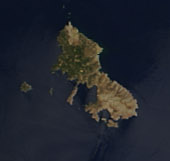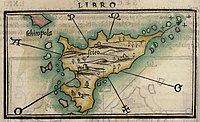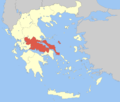Skyros
Skyros
Σκύρος | |
|---|---|
UTC+3 (EEST) | |
| Postal code | 340 07 |
| Area code(s) | 22x0 |
| Vehicle registration | ΧΑ |
Skyros (
Municipality
The municipality Skyros is part of the regional unit of Euboea.[2] Apart from the island Skyros, the municipality consists of the small inhabited island of Skyropoula and a few smaller uninhabited islands. The total area of the municipality is 223.10 km2 (86 sq mi).[3]
Etymology
One account associates the name Skyros with skyron or skiron, meaning "stone debris".[4] The island had a reputation for its decorative stone.[5]
-
Satellite photo of Skyros and Skyropoula
-
Map of Skyros by Benedetto Bordone, 1547
History

According to
In c. 475 BC, according to
In 340 BC, the



After the Fourth Crusade of 1202–1204, the island became part of the domain of Geremia Ghisi. The Byzantines retook it in 1277. After the Fall of Constantinople, Venetians again ruled the island until 1538, when it passed to the Ottoman Empire. It became part of the new Greek state in 1830.
In 1848, Captain Thomas Graves surveyed Skyros for the British Admiralty in the frigate HMS Volage. He travelled around the island, and a record of his observations was published the following year.[8]
Rupert Brooke, the famous English poet, is buried on Skyros, having died on board a French hospital-ship moored off the island on 23 April 1915, during World War I.[9] Present at Brooke's burial that same evening, were Patrick Shaw-Stewart and William Denis Browne.[10] The tomb that visitors see today when they visit the grave, which is located in the Tris Boukes Bay, is one that was commissioned by Brooke’s mother and was placed after the 1st World War. On the tomb is an inscription of Brooke's famous poem The Soldier.[11]
In 1941 Pulitzer Prize-winning poet Karl Shapiro wrote the World War II poem Scyros, which he set on the island Skyros "because it was a tribute to and irony upon Rupert Brooke."[12]
In 1963 the Archaeological Museum of Skyros was established, with the inauguration taking place 10 years later in 1973. The Faltaits Folklore Museum was founded in 1964[13] - one of the first local folklore museums to operate in Greece.[14]
Spanish flu
In 1918, during the spanish flu, approximately one third of the island's population died in less than 30 days. Specifically, the influenza began on 27 October 1918, and of the 3,200 inhabitants on the island, almost 2,000 were infected and 1,000 died.[15] Konstantinos Faltaits described the dire consequences of the pandemic in a rare chronicle published in 1919, titled Ἡ γρίππη στὴ Σκῦρο 'The flu in Skyros'.[16]
Geography
The north of the island is covered by a forest, while the south, dominated by the highest mountain, called Kochila, (792 m), is bare and rocky. The island's capital is also called Skyros (or, locally, Chora). The main port, on the west coast, is Linaria. The island has a castle (the kastro) that dates from the Venetian occupation (13th to 15th centuries), a Byzantine monastery (the Monastery of Saint George), the grave of English poet Rupert Brooke in an olive grove by the road leading to Tris Boukes harbour. There are many beaches on the coast. The island has its own breed of Skyrian ponies.
Climate
Skyros has a hot-summer Mediterranean climate (Csa) with mild to cool, rainy winters and pleasantly warm, dry summers.
| Climate data for Skyros airport (1955-2010) HNMS
| |||||||||||||
|---|---|---|---|---|---|---|---|---|---|---|---|---|---|
| Month | Jan | Feb | Mar | Apr | May | Jun | Jul | Aug | Sep | Oct | Nov | Dec | Year |
| Mean daily maximum °C (°F) | 12.3 (54.1) |
12.7 (54.9) |
14.1 (57.4) |
17.7 (63.9) |
22 (72) |
26.3 (79.3) |
27.9 (82.2) |
27.6 (81.7) |
24.7 (76.5) |
20.8 (69.4) |
17.2 (63.0) |
13.9 (57.0) |
19.8 (67.6) |
| Mean daily minimum °C (°F) | 7.4 (45.3) |
7.4 (45.3) |
8.7 (47.7) |
11.4 (52.5) |
15 (59) |
19.3 (66.7) |
21.7 (71.1) |
21.7 (71.1) |
18.8 (65.8) |
15.5 (59.9) |
12 (54) |
9.1 (48.4) |
14.0 (57.2) |
| Average precipitation mm (inches) | 70.6 (2.78) |
55.3 (2.18) |
49.9 (1.96) |
24.3 (0.96) |
15.4 (0.61) |
6.5 (0.26) |
5.9 (0.23) |
8.4 (0.33) |
19.4 (0.76) |
36.7 (1.44) |
54.6 (2.15) |
81.1 (3.19) |
428.1 (16.85) |
| Source: HNMS (1955-2010 averages)[17] | |||||||||||||
Historical population
| Year | Population |
|---|---|
| 1981 | 2,757 |
| 1991 | 1,806 |
| 2001 | 2,602 |
| 2011 | 2,994 |
| 2021 | 3,052 |
Transportation
Air travel
Skyros is home to the Skyros Island National Airport, a one-runway airport.
Sea travel
Skyros Shipping Company operates the ferry service to Skyros. During holiday season the ferry runs twice daily from Kymi to Linaria on Skyros. During the winter months the service operates daily.[18] The ship has the name "Achilleas SKYROS SHIPPING CO." (Greek: Αχιλλέας ΣΚΥΡΟΣ ΝΑΥΤΙΚΗ ΕΤΑΙΡΙΑ).
Gallery
-
View of Chora
-
Street of Skyros
-
Aerial view
-
Skyros pony
-
Fest during the carnival
-
Brooke Square
-
Traditional dress (Vraka) of Skyros
-
Archaeological Site of Palamari
-
Agios Nikolaos Church in Molos
-
Shipwreck on Agalipas Beach
References
- ^ "Αποτελέσματα Απογραφής Πληθυσμού - Κατοικιών 2021, Μόνιμος Πληθυσμός κατά οικισμό" [Results of the 2021 Population - Housing Census, Permanent population by settlement] (in Greek). Hellenic Statistical Authority. 29 March 2024.
- ^ "ΦΕΚ A 87/2010, Kallikratis reform law text" (in Greek). Government Gazette. Archived from the original on 2021-10-23. Retrieved 2021-09-07.
- ^ "Population & housing census 2001 (incl. area and average elevation)" (PDF) (in Greek). National Statistical Service of Greece. Archived (PDF) from the original on 21 September 2015. Retrieved 11 November 2016.
- ^ "History of Skyros Island". 2016. Archived from the original on 8 February 2021. Retrieved 9 November 2018.
"Skiron" or "Skyron" means "stone debris".
- ISBN 9782867812446. Archivedfrom the original on 8 February 2021. Retrieved 9 November 2018.
The breccias of the Greek island of Skyros were largely used since Roman times for their beauty and low price.
- ^ Homer. Iliad. Vol. 19.326.
- ^ See scholia (bT) ad Iliad 9.326 for the latter story and the harbor's name.
- JSTOR 1798090.
- ^ "Rupert Brooke". Archived from the original on 5 April 2010. Retrieved 2 January 2010.
- ^ Blevins, Pamela (2000). "William Denis Browne (1888–1915)". Musicweb International. Archived from the original on 12 June 2018. Retrieved 9 November 2007.
- ^ "Grave of Rupert Brooke". Archived from the original on 8 February 2021. Retrieved 15 November 2019.
- OCLC 17651234.
- ^ "museum". users.otenet.gr. Archived from the original on 2019-06-14. Retrieved 2018-11-09.
- ^ "Guide to the island of Skyros". Archived from the original on 8 February 2021. Retrieved 23 February 2018.
- PMID 31186675.
- ^ Καλαμαράς, Βασίλης Κ. (9 November 2020). "Κωνσταντίνος Φαλτάιτς (1891-1944): Το χρονικό της ισπανικής γρίππης στη Σκύρο". Enetpress (in Greek).
- ^ "Climatic Data by City,HNMS, Hellenic National Meteorological Service".
- ^ "Skyros Island Beach Guide". Greek Islands Postcards. Archived from the original on 28 March 2020.
- Sporades at the official website of the Greek National Tourism Organisation
- The official website of the Skyros Shipping Company
External links
 Media related to Skyros at Wikimedia Commons
Media related to Skyros at Wikimedia Commons













